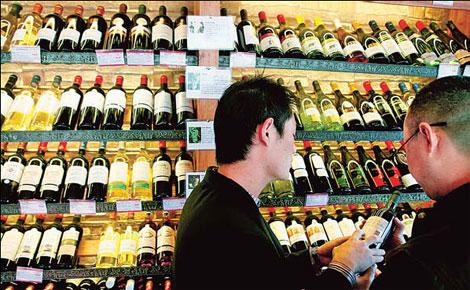
Customers choosing wines at a supermarket in Zhengzhou, Henan province. Wine consumption in China is expected to reach 900 million liters by 2013 compared with 675 million liters in 2008. [Sha Lang / for China Daily]
HONG KONG - Dynasty Fine Wines Group Ltd, part-owned by France's second-biggest liquor company, may spend almost $150 million to boost capacity by 43 percent to meet rising demand in China.The Tianjin-based company may buy vineyards in Australia, New Zealand, Chile or France and has 1 billion yuan ($146 million) in cash, Chairman Bai Zhisheng said in an interview on Tuesday. Dynasty wants to raise production to 100,000 metric tons annually within three years, from 70,000 metric tons now, he said.
"There are only a few available locations for vineyards in China," Bai said. The company is looking mostly to New World wine regions because they "have different harvesting seasons and that complements our production schedule as well."
The executive estimates "double-digit" sales growth this year, driven by demand in China, where rising household incomes are boosting wine consumption. China is on track to become the world's seventh-largest wine market by 2013, according to a study by the Vinexpo Asia-Pacific industry exhibition and market researcher International Wine and Spirit Record.
"China is still a relatively young market for wines, and consumers are just starting to enjoy them," Bai said. "Demand is fast-growing and the market potential is huge."
Dynasty is also surveying potential assets in France, attracted to the country's quality grape vintages and varieties, Bai said.
China production
Dynasty, which is 27 percent owned by Remy Cointreau SA, is also looking to expand wine production in the world's fastest-growing major economy.
Chinese output of the beverage is about 1 million metric tons a year, meeting a fraction of demand, Bai said.
Dynasty estimates domestic demand for wine will rise 10 percent this year. Consumption may increase to 900 million liters in 2013 from 675 million liters in 2008, according to the Vinexpo/IWSR study. Red wines account for 88 percent of all wines consumed in China, the study showed.
Dynasty rose 3.7 percent to HK$2.80 in Hong Kong on Wednesday. The stock has risen 11 percent this year, compared with a 12 percent decline in the benchmark Hang Seng Index.
The company typically invests between 100 million yuan and 200 million yuan a year to expand and capital spending will remain steady during the next three years, Bai said.
Net income in 2009 rose 9.1 percent to HK$156.1 million ($20 million) and sales gained 8.9 percent to HK$1.48 billion, according to a March 31 company filing to the stock exchange.
China is the world's fastest-growing wine market, said Dominique Heriard-Dubreuil, chairwoman of Vinexpo Overseas.
"There is an overall trend of drinking more wines and they want to be part of the trend," she said. "The market is growing in all dimensions and sophisticated consumption is part of it."
Still, beer and local white liquor, known as "baijiu" and produced by companies including Kweichow Moutai Co, will remain the most popular alcoholic beverages in China, Bai said.
Dynasty exports small volumes of its output to about 10 countries globally, including the US, France, Italy, Japan, the Philippines and Singapore, Bai said. The company also supplies Chinese embassies overseas, he said.
"I want the best quality of the old world vintages and the production scale of the new world wines," Bai said. "I want people overseas to taste Chinese wines."
Bloomberg News





